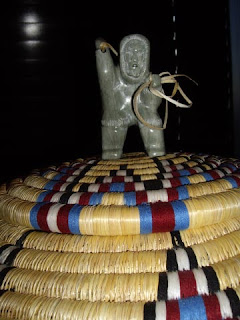 The bumper sticker said it all. I certainly wasn't in painfully PC Vancouver anymore. I had embarked on a journey into a world so different from my own it's hard to believe it's still in the same country. Mind you, this is Canada after all, and you can travel a long, long way without crossing an international border. It took me longer to fly to Iqaluit way up in Canada's northeast than it would have taken for me to fly to Bali. That's far.
The bumper sticker said it all. I certainly wasn't in painfully PC Vancouver anymore. I had embarked on a journey into a world so different from my own it's hard to believe it's still in the same country. Mind you, this is Canada after all, and you can travel a long, long way without crossing an international border. It took me longer to fly to Iqaluit way up in Canada's northeast than it would have taken for me to fly to Bali. That's far.
 The first thing that hits you as you step off the airplane is the cold. My flight was greeted by temperatures dipping below -20 Celsius, and winds gusting over 50 km/hr. The conditions were such that the plane was forced to stop on the tarmac about a two minute walk from the terminal. Seasoned northern travellers are prepared for such occurrences by keeping their winter clothes on board as carry-on. I walked to the terminal in my light sweater and t-shirt, shivering and cursing the entire way. By the time I got inside, my right eye had frozen completely shut. My guess is that the locals were mocking me by loudly discussing how wonderful it was that spring had finally arrived. I kept my mouth shut and attempted to defrost my face.
The first thing that hits you as you step off the airplane is the cold. My flight was greeted by temperatures dipping below -20 Celsius, and winds gusting over 50 km/hr. The conditions were such that the plane was forced to stop on the tarmac about a two minute walk from the terminal. Seasoned northern travellers are prepared for such occurrences by keeping their winter clothes on board as carry-on. I walked to the terminal in my light sweater and t-shirt, shivering and cursing the entire way. By the time I got inside, my right eye had frozen completely shut. My guess is that the locals were mocking me by loudly discussing how wonderful it was that spring had finally arrived. I kept my mouth shut and attempted to defrost my face. The sun does shine in the Arctic (quite often, in fact), and when it does the stark beauty of the place is stunning. Shown here is Iqaluit from the neighbouring village of Apex, looking across Frobisher Bay. Mind you, without the clouds the temperature drops. It was -34 one deceptively sunny morning.
The sun does shine in the Arctic (quite often, in fact), and when it does the stark beauty of the place is stunning. Shown here is Iqaluit from the neighbouring village of Apex, looking across Frobisher Bay. Mind you, without the clouds the temperature drops. It was -34 one deceptively sunny morning.
The ocean freezes in the northern winters, and the combination of tides and wind results in an incredible mish-mash of broken ice, with striking, twisted shards forming beautiful modern sculptures.
 Nature isn't the only artist in the north. The Inuit people are famous for fine soapstone sculptures. This carving of a traditional hunter was perched atop a traditional weaved basket, and fetched a whopping $3,000 at an auction I attended.
Nature isn't the only artist in the north. The Inuit people are famous for fine soapstone sculptures. This carving of a traditional hunter was perched atop a traditional weaved basket, and fetched a whopping $3,000 at an auction I attended.
 Other indigenous art includes fashion, utilizing local furs such as seal, caribou and polar bear. These would probably not be practical in rainy Vancouver, as persons wearing such fashion would immediately be shot by someone who lives between Commercial and Victoria Drives.
Other indigenous art includes fashion, utilizing local furs such as seal, caribou and polar bear. These would probably not be practical in rainy Vancouver, as persons wearing such fashion would immediately be shot by someone who lives between Commercial and Victoria Drives.
 Still, Lord knows how I love to shop, so I picked up two of these outfits...
Still, Lord knows how I love to shop, so I picked up two of these outfits...
 And so Iqaluit evokes a wide variety of emotions along with its barren landscape and occasional discarded tire...
And so Iqaluit evokes a wide variety of emotions along with its barren landscape and occasional discarded tire... ...or boat left to the mercy of the ice.
...or boat left to the mercy of the ice. The conditions are pretty harsh for any living creature, including the dogs and crows...
The conditions are pretty harsh for any living creature, including the dogs and crows... ...although I certainly wouldn't want to be a local polar bear!
...although I certainly wouldn't want to be a local polar bear!

 Where does it all lead? Hopefully not here!
Where does it all lead? Hopefully not here!



